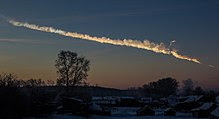Any actual asteroid strike on Earth is a relatively rare event, especially in the modern era. The most recent event of note was the Chelyabinsk asteroid explosion in February, 2013, e.g.
Image of the Chelyabinsk asteroid's exploded trail over Chelyabinsk, Russia, in 2013.
The object was estimated at 66 ft. diameter and packing an energy equivalent of 30 Hiroshima -scale atomic bombs. The energy was sufficient to injure over 1,000 in the Russian city - mainly from the shock wave produced - with flying debris and shattered windows the culprits.
Now, as reported in Eos: Science News (April, p. 12), Elmar Buchner, a geologist at the Neu-Ulm University of Applied Sciences in Nue-Ulm, Germany, and his colleagues have investigated the provenance of two impact craters near Stuttgart using observational data. They have concluded that a double asteroid struck about 14.8 m years ago in the Miocene epoch.
Initially the 2 impact craters in close proximity triggered the hypothesis of a binary asteroid impact. A binary asteroid, like a binary star, being two objects that orbit one another. Our planet is dotted with nearly 200 confirmed impact structures, and a handful of them appear in close pairs. Some researchers have proposed that these apparent double craters are scars created by binary asteroids slamming into Earth at the same time.
According to William Bottke, a planetary scientist (not involved in the actual research) at the Southwest Research Institute in Boulder, Colo., this makes sense. As he explained (ibid.): "We don’t have that many craters on the Earth. When you see two sitting right next to one another, it’s natural to think there’s an association."
But that isn't what the German scientists found.
Argon-40/argon-39 age dating revealed the Ries crater formed about 14.8 million years ago during the Miocene epoch. Buchner and his collaborators investigated outcroppings of rock in the region around the craters and found a layer of jumbled, fractured sediments. That wasn’t a surprise given that such seismites are a sign that powerful seismic waves passed through the region. These waves would have certainly occurred after an asteroid impact.
However, the researchers found that this seismitic horizon was crosscut by a second horizon, this one consisting of vertical tubelike features known as clastic dikes. The discovery of these two distinct seismite units is evidence of two separate episodes of ground shaking, Buchner and his colleagues concluded. That rules out a strike by a binary asteroid, which would have launched just one round of seismic waves.
The impact that created the Ries crater must have formed first, the scientists surmised, because blocks of limestone—ejecta from the Ries impact—cap the lower seismite horizon. That’s consistent with previous research suggesting that fossils within the Ries crater are a few hundred thousand years older than fossils found within the Steinheim Basin.
Scientists have theoretically determined that the binary asteroid scenario is unlikely. That’s because most binary asteroids are orbiting one another too closely to produce two distinct craters were they to slam into a rocky body. This was shown by Bottke and his colleagues back in the 1990s. “If you’re going to get two separate craters from the impact of a binary asteroid, they have to be pretty well separated,” said Bottke.
The German team focused on the 24-kilometer-diameter Ries crater—which encompasses the town of Nördlingen—and the 4-kilometer-diameter Steinheim Basin, which are located roughly 40 kilometers from one another
This region “witnessed a double disaster in the Middle Miocene,” the team concluded in their paper, which was published last month in Scientific Reports. That’s rare but not unheard of, said Bottke. “If you only have so much terrain and you keep adding craters, eventually, two are going to be very close to one another, just by chance.”
The nature of this present work suggests it might be a useful exercise to estimate the comparative probabilities for a binary asteroid impact event and a double asteroid event.
See Also:

No comments:
Post a Comment